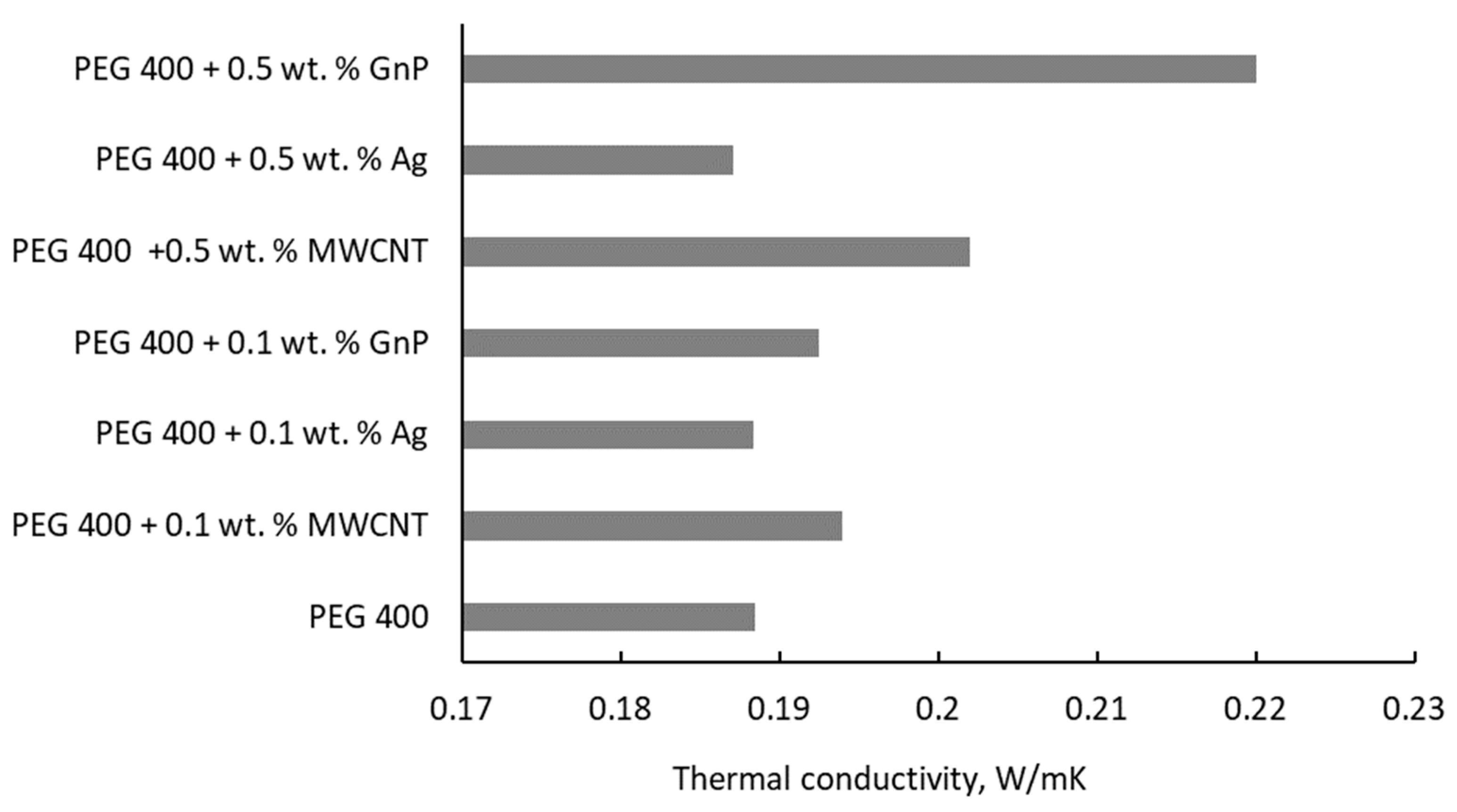State of the Art in PEG-Based Heat Transfer Fluids and Their Suspensions with Nanoparticles
Abstract
1. Introduction
- -
- Thermal properties: good phase transition temperature, good heat transfer capabilities (i.e., especially high thermal conductivity, high specific heat capacity), and a high latent heat;
- -
- Physical properties: good phase equilibrium, high values for density, and small vapor pressure;
- -
- Kinetic properties: no conditions for supercooling and a good crystallization rate;
- -
- Chemical properties: a very good chemical stability over time, lack of toxicity and absence of fire hazard (i.e., lack of flammability), a very good compatibility with other materials from the same system (for example, the construction materials, if applicable to buildings), lack of or low degradation after a number of freezing or melting processes;
- -
- Preferable economic indicators, such as abundancy, large scale availability, and low costs.
2. Polyethylene Glycol as a Phase Change Material
- -
- Chemical applications (as a lubricator, in biochemistry or biomembrane experimental studies, as a surfactant, as a calibration compound in mass spectrometry, etc.);
- -
- Medicine (use as an excipient, for example);
- -
- Biology (as a crowding agent, for protein crystallization)
- -
- Commercial uses (in tattoos for monitoring diabetes, as an anti-foaming agent in several food and drink products, as a compound in skin creams, as a dispersant for toothpaste, etc.)
- -
- Industrial applications (as an anti-foaming agent, in technical ceramics, as an insulator, etc.);
- -
- Recreational applications.
3. Nanoparticle Enhanced PEG for Convective Heat Transfer Applications
3.1. Thermal Conductivity
3.2. Density
- Density decreases when temperature increases.
- Density of the nanoparticle enhanced PEG slightly increases with nanoparticle concentration.
3.3. Viscosity
3.4. Specific Heat Capacity
4. Conclusions
Funding
Institutional Review Board Statement
Informed Consent Statement
Data Availability Statement
Conflicts of Interest
References
- Zalba, B.; Marın, J.M.; Cabeza, L.F.; Mehling, H. Review on thermal energy storage with phase change: Materials, heat transfer analysis and applications. Appl. Therm. Eng. 2003, 23, 251–283. [Google Scholar] [CrossRef]
- Sharma, A.; Tyagi, V.V.; Chen, C.R.; Buddhi, D. Review on thermal energy storage with phase change materials and applications. Renew. Sustain. Energy Rev. 2009, 13, 318–345. [Google Scholar] [CrossRef]
- Waqas, A.; Din, Z.U. Phase change material (PCM) storage for free cooling of buildings—A review. Renew. Sustain. Energy Rev. 2013, 18, 607–625. [Google Scholar] [CrossRef]
- Zhou, D.; Zhao, C.Y.; Tian, Y. Review on thermal energy storage with phase change materials (PCMs) in building applications. Appl. Energy 2012, 92, 593–605. [Google Scholar] [CrossRef]
- Osterman, E.; Tyagi, V.V.; Butala, V.; Rahim, N.A.; Stritih, U. Review of PCM based cooling technologies for buildings. Energy Build. 2012, 49, 37–49. [Google Scholar] [CrossRef]
- Giro-Paloma, J.; Martínez, M.; Cabeza, L.F.; Fernández, A.I. Types, methods, techniques, and applications for microencapsulated phase change materials (MPCM): A review. Renew. Sustain. Energy Rev. 2016, 53, 1059–1075. [Google Scholar] [CrossRef]
- Cabeza, L.F. Advances in Thermal Energy Storage Systems—Methods and Applications; Elsevier: Amsterdam, The Netherlands, 2014. [Google Scholar]
- Gómez-Merino, A.I.; Jiménez-Galea, J.J.; Rubio-Hernández, F.J.; Arjona-Escudero, J.L.; Santos-Ráez, I.M. Heat Transfer and Rheological Behavior of Fumed Silica Nanofluids. Processes 2020, 8, 1535. [Google Scholar] [CrossRef]
- Marcos, M.A.; Cabaleiro, D.; Guimarey, M.J.G.; Comuñas, M.J.P.; Fedele, L.; Fernández, J.; Lugo, L. PEG 400-Based Phase Change Materials Nano-Enhanced with Functionalized Graphene Nanoplatelets. Nanomaterials 2018, 8, 16. [Google Scholar] [CrossRef]
- Demirbas, M.F. Thermal energy storage and phase change materials: An overview. Energy Sources Part. B 2006, 1, 85–95. [Google Scholar] [CrossRef]
- Ahmad, M.; Bontemps, A.; Sallée, H.; Quenard, D. Thermal testing and numerical simulation of a prototype cell using light wallboards coupling vacuum isolation panels and phase change material. Energy Build. 2006, 38, 673–681. [Google Scholar] [CrossRef]
- Azizi, Y.; Sadrameli, S.M. Thermal management of a LiFePO4 battery pack at high temperature environment using a composite of phase change materials and aluminum wire mesh plates. Energy Convers. Manag. 2016, 128, 294–302. [Google Scholar] [CrossRef]
- Ismail, K.A.R.; Castro, J.N.C. PCM thermal insulation in buildings. Int. J. Energy Res. 1997, 21, 1281–1296. [Google Scholar] [CrossRef]
- Zhang, D.; Chen, M.; Wu, S.; Liu, Q.; Wan, J. Preparation of expanded graphite/polyethylene glycol composite phase change material for thermoregulation of asphalt binder. Constr. Build. Mater. 2018, 169, 513–521. [Google Scholar] [CrossRef]
- Tang, B.; Wu, C.; Qiu, M.; Zhang, X.; Zhang, S. PEG/SiO2—Al2O3 hybrid form-stable phase change materials with enhanced thermal conductivity. Mater. Chem. Phys. 2014, 144, 162–167. [Google Scholar] [CrossRef]
- Kou, Y.; Wang, S.; Luo, J.; Sun, K.; Zhang, J.; Tan, Z.; Shi, Q. Thermal analysis and heat capacity study of polyethylene glycol (PEG) phase change materials for thermal energy storage applications. J. Chem. Thermodyn. 2019, 128, 259–274. [Google Scholar] [CrossRef]
- Marcos, M.A.; Podolsky, N.E.; Cabaleiro, D.; Lugo, L.; Zakharov, A.O.; Postnov, V.N.; Charykov, N.A.; Ageev, S.V.; Semenov, K.N. MWCNT in PEG-400 nanofluids for thermal applications: A chemical, physical and thermal approach. J. Mol. Liq. 2019, 294, 111616. [Google Scholar] [CrossRef]
- Marcos, M.A.; Cabaleiro, D.; Hamze, S.; Fedele, L.; Bobbo, S.; Estellé, P.; Lugo, L. NePCM Based on Silver Dispersions in Poly(Ethylene Glycol) as a Stable Solution for Thermal Storage. Nanomaterials 2020, 10, 19. [Google Scholar] [CrossRef]
- Singh, R.; Sadeghi, S.; Shabani, B. Thermal conductivity enhancement of phase change materials for low-temperature thermal energy storage applications. Energies 2019, 12, 75. [Google Scholar] [CrossRef]
- Yang, J.; Tang, L.-S.; Bao, R.-Y.; Bai, L.; Liu, Z.-Y.; Yang, W.; Xie, B.-H.; Yang, M.-B. Largely enhanced thermal conductivity of poly (ethylene glycol)/boron nitride composite phase change materials for solar-thermal-electric energy conversion and storage with very low content of graphene nanoplatelets. Chem. Eng. J. 2017, 315, 481–490. [Google Scholar] [CrossRef]
- Liu, Z.; Wei, H.; Tang, B.; Xu, S.; Shufen, Z. Novel light–driven CF/PEG/SiO2 composite phase change materials with high thermal conductivity. Sol. Energy Mater. Sol. Cells 2018, 174, 538–544. [Google Scholar] [CrossRef]
- Qian, T.; Li, J.; Feng, W.; Nian, H. Single-walled carbon nanotube for shape stabilization and enhanced phase change heat transfer of polyethylene glycol phase change material. Energy Convers. Manag. 2017, 143, 96–108. [Google Scholar] [CrossRef]
- Tang, B.; Wang, Y.; Qiu, M.; Zhang, S. A full-band sunlight-driven carbon nanotube/PEG/SiO2 composites for solar energy storage. Sol. Energy Mater. Sol. Cells 2014, 123, 7–12. [Google Scholar] [CrossRef]
- Cabaleiro, D.; Hamze, S.; Fal, J.; Marcos, M.A.; Estellé, P.; Zyła, G. Thermal and Physical Characterization of PEG Phase Change Materials Enhanced by Carbon-Based Nanoparticles. Nanomaterials 2020, 10, 1168. [Google Scholar] [CrossRef] [PubMed]
- Navidbakhsh, S.; Majdan-Cegincara, R. Effect of c-Fe2O3 nanoparticles on rheological and volumetric properties of solutions containing polyethylene glycol. Int. J. Ind. Chem. 2017, 8, 433–445. [Google Scholar] [CrossRef]
- Yapici, K.; Cakmak, N.K.; Ilhan, N.; Uludag, Y. Rheological characterization of polyethylene glycol based TiO2 nanofluids. Korea-Aust. Rheol. J. 2014, 26, 355–363. [Google Scholar] [CrossRef]
- Marcos, M.A.; Lugo, L.; Ageev, S.V.; Podolsky, N.E.; Cabaleiro, D.; Postnov, V.N.; Semenov, K.N. Influence of molecular mass of PEG on rheological behaviour of MWCNT-based nanofluids for thermal energy storage. J. Mol. Liq. 2018, 318, 113965. [Google Scholar] [CrossRef]
- Meyer, J.P.; Adio, S.A.; Sharifpur, M.; Nwosu, P.N. The Viscosity of Nanofluids: A Review of the Theoretical, Empirical, and Numerical Models. Heat Transf. Eng. 2016, 37, 387–421. [Google Scholar] [CrossRef]
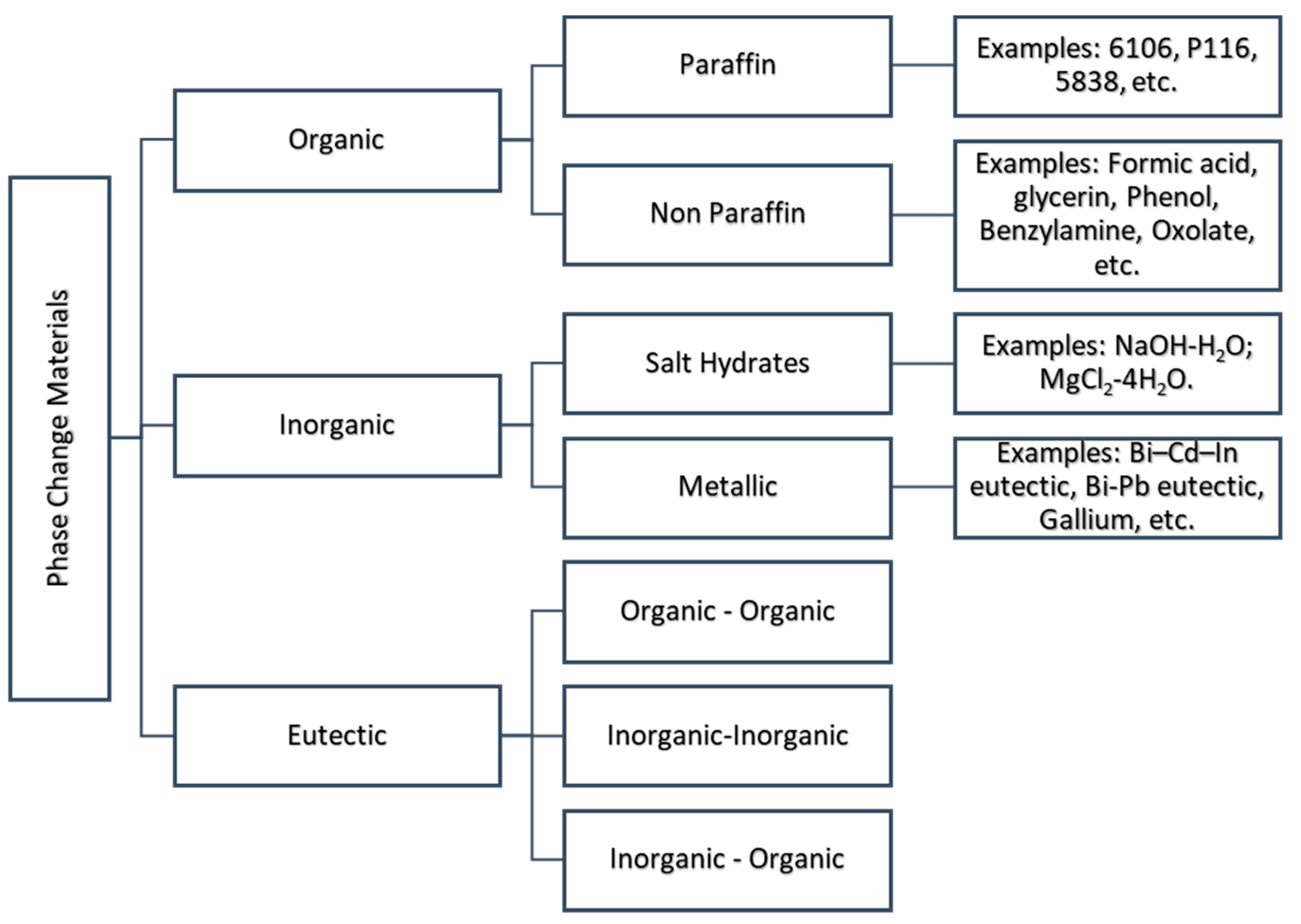
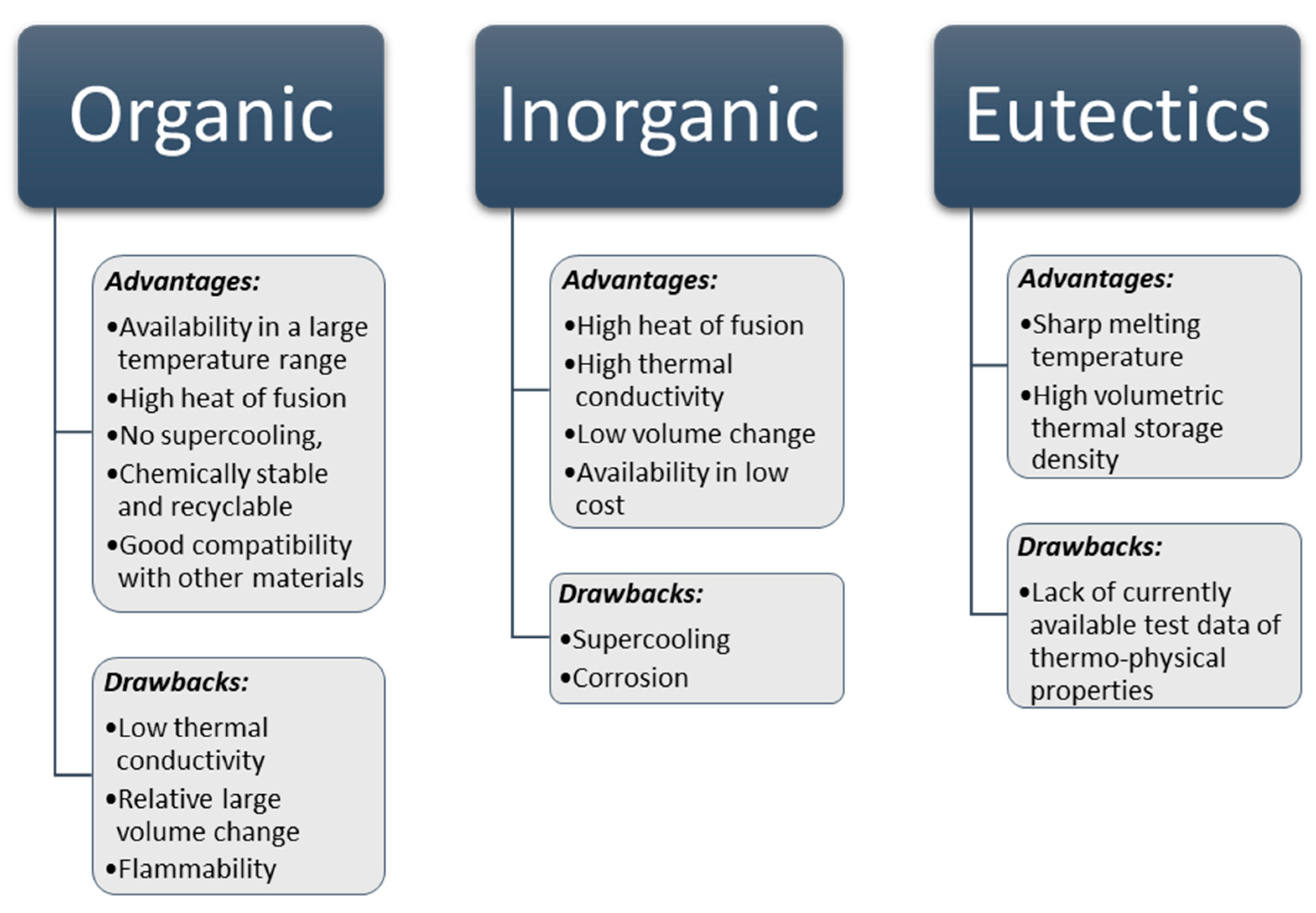
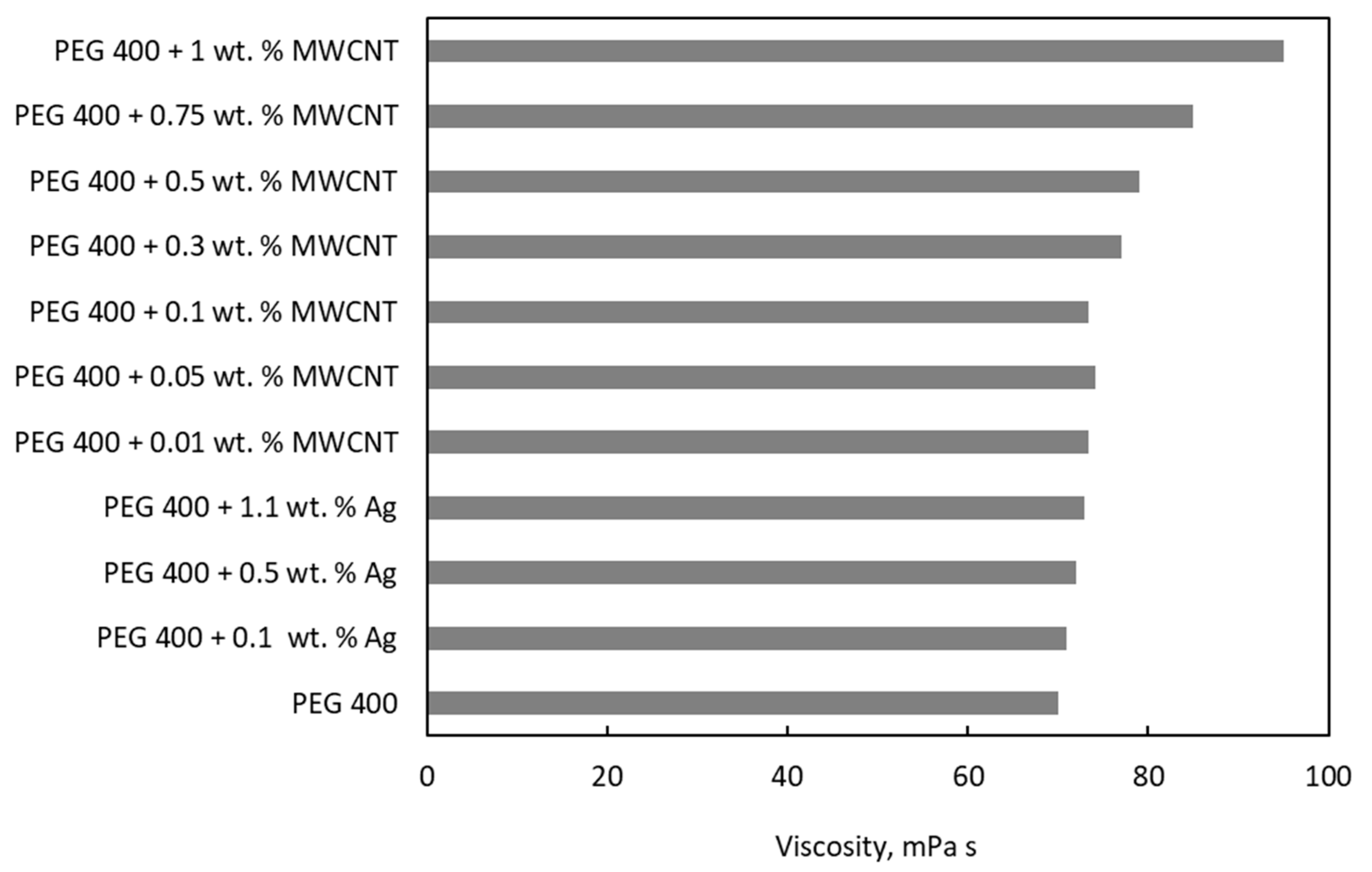
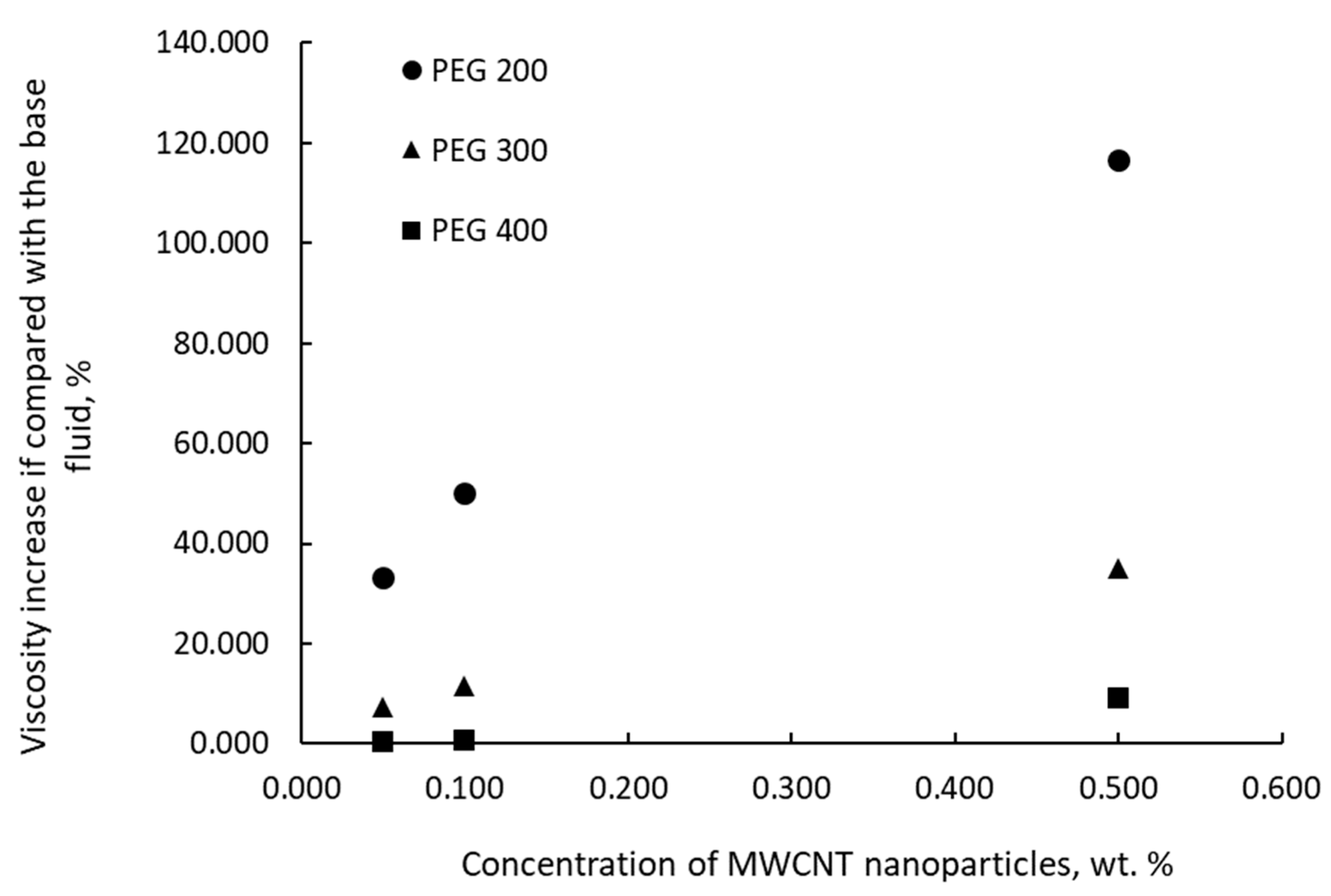
| Average Molecular Weight | Melting Point/Range, °C | Heat of Fusion, kJ/Kg | References | |
|---|---|---|---|---|
| PEG 200 | 200 | −50 | not available | Gomez-Merino et al. [8] |
| PEG 400 | 400 | 5.8 | 105.3 | Marcos et al. [9] |
| PEG 600 | 600 | 22.2 | 127.2 | Demirbas [10] Ahmad et al. [11] |
| PEG 1000 | 1000 | 35–40 | 159 | Azizi and Sadrameli [12] |
| PEG 1000 + PEG 600 | 23–26 | 150.5 | Ismail and Castro [13] | |
| PEG 2000 | 2000 | 35.93 | 172.13 | Zhang et al. [14] |
| PEG 6000 | 6000 | 39.6 | 177.9 | Tang et al. [15] |
| PEG 1500 | 1500 | 47.23 | 161.43 | Kou et al. [16] |
| PEG 4000 | 4000 | 55.95 | 173.62 | Kou et al. [16] |
| PEG 8000 | 8000 | 59.74 | 177.53 | Kou et al. [16] |
| PEG 10000 | 10000 | 58.01 | 182.86 | Kou et al. [16] |
| PEG 12000 | 12000 | 60.93 | 173.4 | Kou et al. [16] |
| PEG 20000 | 20000 | 62.27 | 168.5 | Kou et al. [16] |
| Thermal Conductivity, W/m K (at 298.15 K) | Viscosity, mPa s (at Different Temperatures) | Specific Heat Capacity (at 298.15 K) | Density, kg/m3 (at 298.15 K) | References | |
|---|---|---|---|---|---|
| PEG 200 | 0.190 | 49.72 at 298.15 K | not available | 1120.9 | Gomez-Merino et al. [8] |
| PEG 400 | 0.152 | 70.44 at 298.15 K | not available | 1003.8 | Gomez-Merino et al. [8] |
| 0.184 | 73.4 at 303.15 K | 2.350 kJ/kg K | 1125.3 | Marcos et al. [9] | |
| PEG 600 | not available | 150 at 298.15 K | 2.490 kJ/kg K | 1128 | Ahmad et al. [11] |
| PEG 1000 | 0.23 | not available | 2.142 kJ/kg K | 1093 | Azizi and Sadrameli [12] |
| PEG 1500 | 0.31 | not available | 2.473 kJ/kg K | 1200 | Kou et al. [16] |
| PEG 2000 | 0.31 | not available | 3.116 kJ/mol K | 1210 | |
| PEG 4000 | 0.33 | not available | 5.996 kJ/mol K | 1200 | |
| PEG 6000 | 0.2124 (0.34) | not available | not available (8.996 kJ/mol K) | 1200 | Tang et al. [15] (Kou et al. [16]) |
| PEG 8000 | 0.33 | not available | 11.772 kJ/mol K | 1270 | Kou et al. [16] |
| PEG 10000 | 0.33 | not available | 14.455 kJ/mol K | 1070 | Kou et al. [16] |
| PEG 12000 | 0.32 | not available | 17.550 kJ/mol K | 1200 | Kou et al. [16] |
| PEG 20000 | 0.32 | not available | 28.180 kJ/mol K | 1200 | Kou et al. [16] |
| Reference | Base Fluid | Nanoparticles | Concentration | Conditions | Observation |
|---|---|---|---|---|---|
| Marcos et al. [17] | PEG 400 | MWCNT | 0.01–1 wt. % | Temperature variation in the range 288.15–343.15 K | 1. Thermal conductivity slightly decreases when temperature increases. 2. Thermal conductivity of the liquid inceases with nanoparticle concentration. |
| Marcos et al. [9] | PEG 400 | GnP | 0.05–0.5 wt. % | Temperature variation in the range 283–333 K | 1. Thermal conductivity slightly decreases when temperature increases. 2. Thermal conductivity of the liquid inceases up to 23% with nanoparticle concentration. |
| Marcos et al. [18] | PEG 400 | Ag | 0.1–1.1 wt. % | Temperature variation in the range 283.15–333.15 K | 1. Thermal conductivity remains almost constant when temperature increases. 2. Thermal conductivity of the liquid inceases with nanoparticle concentration. |
| Singh et al. [19] | PEG 1000 | carbon powder | 0.78 and 2.5 wt. % | Ambient temperature | Thermal conductivity of the liquid inceases up to 31% with nanoparticle concentration. |
| Yang et al. [20] | PEG 1000 | GnP | up to 2.5 wt. % | Ambient temperature | Thermal conductivity of the liquid inceases up to 36% with nanoparticle concentration. |
| Liu et al. [21] | PEG 6000 + SiO2 | carbon fiber | 1–5 wt. % | Ambient temperature | Thermal conductivity inceases by 73% if compared to the base fluid and by 164% if compared to PEG 6000. |
| Qian et al. [22] | PEG 6000 | SWCNT | 2–10 wt. % | Temperature variation in the range 293.15–353.15 K | 1. Thermal conductivity remains almost constant when temperature increases. 2. Thermal conductivity of the liquid inceases by 8.55 times at 10% nanoparticle concentration. |
| Tang et al. [15] | PEG 6000 + SiO2 | Al2O3 | 3.3, 9.2, 12.6 wt. % | Ambient temperature | Compared to the pure PEG 6000 and PEG 6000/SiO2 data, the thermal conductivity of the composite PCM with Al2O3 inceases up to 46.5% and 20.8%, respectively. |
| Tang et al. [23] | PEG 6000 + SiO2 | MWCNT | 1–4 wt. % | Ambient temperature | Compared to the pure PEG 6000 and PEG 6000/SiO2 data, the thermal conductivity of the composite PCM with MWCNTs inceases up to 56% and 29%, respectively. |
| Cabaleiro et al. [24] | PEG 400 | carbon black nano-diamonds graphite/diamond nanomixture | 0.5 and 1 wt. % | Temperature variation in the range 288.15–318.15 K | 1. Thermal conductivity remains almost constant when temperature increases. 2. Thermal conductivity of the liquid inceases up to 3.6% depending on nanoparticle type and concentration. The largest increase was for graphite/diamond nanomixture. |
| Reference | Base Fluid | Nanoparticles | Concentration | Conditions | Observation |
|---|---|---|---|---|---|
| Marcos et al. [17] | PEG 400 | MWCNT | 0.01–1 wt. % | Temperature variation in the range 288.15–313.15 K | 1. Density decreases when temperature increases 2. Density of the liquid increases up to 0.5% depending on nanoparticle concentration. |
| Marcos et al. [9] | PEG 400 | GnP | 0.05–0.5 wt. % | Temperature variation in the range 288.15–313.15 K | 1. Density decreases when temperature increases 2. Density of the liquid increases up to 1.5% depending on nanoparticle concentration. |
| Marcos et al. [18] | PEG 400 | Ag | 0.1–1.1 wt. % | Temperature variation in the range 288.15–313.15 K | 1. Density decreases when temperature increases 2. Density of the liquid increases up to 2.5% depending on nanoparticle concentration. |
| Cabaleiro et al. [24] | PEG 400 | carbon black nano-diamonds graphite/diamond nanomixture | 0.5% and 1 wt. % | Temperature variation in the range 288.15–313.15 K | 1. Density decreases when temperature increases 2. Density of the liquid increases up to 40% depending on nanoparticle concentration and type. |
| Navidbakhsh and Majdan-Cegincara [25] | PEG 400, PEG 400 + PEG 2000, PEG 400 + PEG 6000 | Fe2O3 | 0.1–31.8 vol. % | Temperature variation in the range 298.15–318.15 K | 1. Density decreases when temperature increases 2. Density of the liquid increases up to 1.5% depending on nanoparticle concentration. |
| Reference | Base Fluid | Nanoparticles | Concentration | Conditions | Observation |
|---|---|---|---|---|---|
| Marcos et al. [17] | PEG 400 | MWCNT | 0.01–1 wt. % | Temperature variation in the range 288.15–343.15 K | Viscosity increases with nanoparticle addition up to 30% and decreases with temperature. |
| Marcos et al. [18] | PEG 400 | Ag | 0.1–1.1 wt. % | Temperature variation in the range 273.15–343.15 K | Viscosity increases with nanoparticle addition is very low. Viscosity decreases with temperature. |
| Cabaleiro et al. [24] | PEG 400 | carbon black nano-diamonds graphite/diamond nanomixture | 0.5 and 1 wt. % | Temperature variation in the range 288.15–318.15 K | 1. Viscosity decreases when temperature increases 2. Viscosity of the suspensions increases up to 31.8% depending on nanoparticle type and concentration. The largest increase was for carbon black at 1 wt. %, and the minimum was 5% for 0.5% nanodiamond. |
| Yapici et al. [26] | PEG 200 | TiO2 | 1–10 wt. % | Temperature variation in the range 263.15–313.15 K | PEG 200 has a Newtonian behaviour, and all new fluids are non-Newtonian. Viscosity increases with nanoparticle addition. An increasing shear thinning trend with temperature was noticed. Viscosity decreases with temperature. |
| Navidbakhsh and Majdan-Cegincara [25] | PEG 400, PEG 400 + PEG 2000, PEG 400 + PEG 6000 | Fe2O3 | 0.1–31.8 vol. % | Temperature variation in the range 298.15–318.15 K | Several models existing in the literature were checked for compliance with experimental data. Newtonian behavior was observed for PEG 400 and shear thickening for both PEG 400 + PEG 2000 and PEG 400 + PEG 6000. A pseudoplastic behavior was noticed for all fluids with nanoparticles. |
| Marcos et al. [27] | PEG 200 PEG 300 | MWCNT | 0.025–0.7 wt. % | Temperature variation in the range 278.15–303.15 K | PEG 200 and PEG 300 have a Newtonian behaviour, and all new fluids are non-Newtonian. Viscosity increases with nanoparticle addition up to 105% and decreases with temperature. |
Publisher’s Note: MDPI stays neutral with regard to jurisdictional claims in published maps and institutional affiliations. |
© 2021 by the author. Licensee MDPI, Basel, Switzerland. This article is an open access article distributed under the terms and conditions of the Creative Commons Attribution (CC BY) license (http://creativecommons.org/licenses/by/4.0/).
Share and Cite
Minea, A.A. State of the Art in PEG-Based Heat Transfer Fluids and Their Suspensions with Nanoparticles. Nanomaterials 2021, 11, 86. https://doi.org/10.3390/nano11010086
Minea AA. State of the Art in PEG-Based Heat Transfer Fluids and Their Suspensions with Nanoparticles. Nanomaterials. 2021; 11(1):86. https://doi.org/10.3390/nano11010086
Chicago/Turabian StyleMinea, Alina Adriana. 2021. "State of the Art in PEG-Based Heat Transfer Fluids and Their Suspensions with Nanoparticles" Nanomaterials 11, no. 1: 86. https://doi.org/10.3390/nano11010086
APA StyleMinea, A. A. (2021). State of the Art in PEG-Based Heat Transfer Fluids and Their Suspensions with Nanoparticles. Nanomaterials, 11(1), 86. https://doi.org/10.3390/nano11010086




